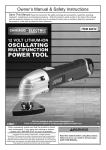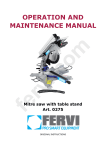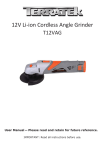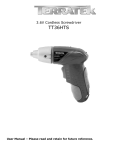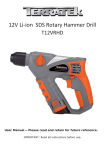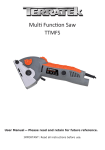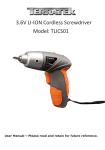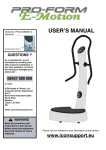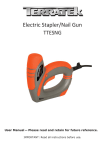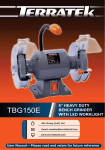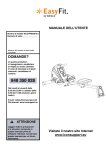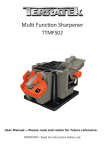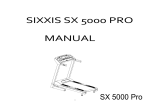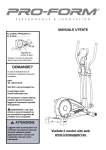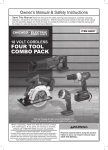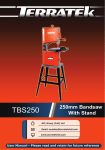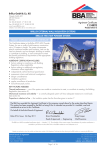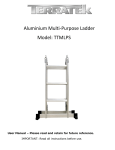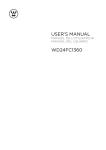Download TTMTWEB - User Manual
Transcript
10.8V Cordless Multi purpose oscillating tool TTMTWEB User Manual – Please read and retain for future reference. Contents Parts List Technical Information Safety Instructions Using your tool Maintenance Warranty Accessories B A C G H D I E F A B C D E F G H I J Sanding pad 32mm Wood blade Scraper Bolt Washers Sanding sheets HSS segment saw blade Diamond segment saw blade Wrench 35mm E-cut saw blade J D A B E C F G Fi g.1 A- On/Off switch B- Variable speed control C- Tool holder D- Battery E- Battery F- Charging adapter G- Power supply Fig.2 Fig.3 Fig.4 Fig.5 Parts List No 1 2 3 4 5 6 7 8 9 10 11 12 13 14 15 16 17 18 19 20 21 22 23 24 25 Description Screw M8X12 Outside Flange Spindle Rubber Casing Circlip for Shaft 26 Spline Spring Washer Bearing 6000 Block Bushing Screw ST4x24 Reducer Circlip For Shaft 4 Bearing 625 Eccentric Spindle Bearing 608 Screw M3.0X18 Seal Collar Middle Cover Seal Packing Collar Motor Seal Packing Collar Trigger Right Plastic Housing Name Plate Screw ST3X14 No 26 27 28 29 30 31 32 33 34 35 36 37 38 39 40 41 42 43 501 502 503 504 505 506 507 Description Switch Screw ST3X10 Switch Housing Contact Left Plastic Housing Variable speed switch Battery Cover-Front Steel NI-PLATED Pole End Plate Armature Paper Battery(Lithium-ion) EVA Plate Battery PCB Armature Paper EVA Plate Battery Cover-Back Screw ST2.5x8 Name plate Charger Charger Housing Hexagon Wrench Fixed Scraper Blade Standard E-cut Saw Blade 82mm Grinding Pad Sandpaper Exploded Assembly Diagram NOTICE: Actual product may vary from pictures shown. Technical Information Voltage: Battery: Speed: Oscillating angle: Noise pressure level: Uncertainty : Noise power level: Uncertainty: Oscillation emission value: Uncertainty: N.W./G.W.: 10.8v DC 1300 mAh Lithium-ion 5000 - 16000 min-1 3° LPA: 72.0 dB(A) KPA:3 dB(A) LWA: 83.0 dB(A) KWA: 3 dB(A) ah 2.83m/s2 K = 1.5 m/s2 1.5/1.8kgs Battery: Operating voltage battery: Battery cell: 10.8v DC Lithium ion battery, 1300 mAh Read this entire manual before using this product. Failure to do so can result in serious injury. Save this manual for future reference. Copyright© 2012 by ACL (Intl.) Ltd. All rights reserved. This manual or any artwork contained herein must not be reproduced in any shape or form without the express written consent of ACL (Intl.) Ltd. Diagrams within this manual may not be drawn proportionally. Due to continuing improvements, actual product may differ slightly from the product described herein. Read and Keep This Manual Please read carefully all instructions within this manual. Failure to follow all safety warnings can result in serious personal injury. The term “Power Tool” in all of the following warnings refers to your mains operated (corded) or battery operated (cordless) power tool Important SAFETY Information This symbol is to warn you of potential personal injury hazards. Please read carefully the notes alongside this warning to avoid possible injury or death. General Safety Rules WARNING! Read all instructions. Failure to follow all instructions listed below may result in electric shock, fire and/or serious injury. The term “power tool” in all of the warnings listed refers to corded or cordless power tools. Work area safety Keep work area clean and well lit. Cluttered or dark areas invite accidents. Do not operate power tools in explosive atmospheres, such as in the presence of flammable liquids, gases or dust. Power tools create sparks which may ignite the dust or fumes. Keep children and bystanders away while operating a power tool. Distractions can cause you to lose control. Electrical safety Before use, ensure that the power outlet you are using matches the plug on your power tool and that the voltage of the outlet matches that of your power tool. Only use grounded extension cords with power tools fitted with 3 pin plugs and if using outdoors ensure any extension cord is suitable for outdoor use. Always try to avoid body contact with grounded surfaces, such as radiators, cooking ranges and any other fixed appliance with metal surfaces. Do not expose your power tool to wet or damp conditions and NEVER use in rain. Check regularly the power cord of your machine and any extension cord that you are using for damage. Do not carry or pull the machine with the power cord. Ensure the cord is clear from hot surfaces, oil or sharp objects. Personal safety Never use your power tool whilst under the influence of alcohol, drugs or medication. Tiredness can often cause accidents, stay alert. Never use your power tool without the correct guards in place. Always use ANSI approved eye protection and dust mask. Non slip safety shoes and hearing protectors should be worn at all times when using your power tool. Ensure any dust collecting device supplied with your machine is connected correctly before use. Ensure all loose clothing, long hair or jewelry is kept clear of the machine. Before plugging your power tool into the power outlet ensure the power tool is in the OFF position. Check that wrenches or adjusting keys have been removed. Any wrench or key left attached to a moving part can result in injury. Power tool use and care. Keep your power tool clean and well serviced at all times. Never adjust or service any power tool before disconnecting from the mains electricity supply. Always use the correct tool for the job. Never force the tool to work harder than it is designed to do. Never use your power tool with broken parts such as switches, guide fences or leg stands. ALWAYS keep your power tools away from children. Keep cutting tools sharp to ensure less stress on the motor. Only have your power tool serviced by a qualified repair agent using manufacturers recommended parts. Service Have your power tool serviced by a qualified repair person using only identical replacement parts. This will ensure that the safety of the power tool is maintained. Develop a periodic maintenance schedule for your tool. When cleaning a tool be careful not to disassemble any portion of the tool since internal wires may be misplaced or pinched or safety guard return springs may be improperly mounted. Certain cleaning agents such as gasoline, carbon tetrachloride, ammonia, etc. may damage plastic parts. When servicing a tool, use only identical replacement parts. Follow instructions in the Maintenance section of this manual. Use of unauthorized parts or failure to follow Maintenance Instructions may create a risk of electric shock or injury. WARNING: For your own safety read Instruction Manual before operating your power tool. A) Wear eye protection. B) Keep hands out of the path of cutting tools. C) Do not operate tool without guards in place. D) Do not perform any operation freehand. E) Never reach around cutting tools. F) Turn off tool and wait for cutting tools to stop before moving workpiece or changing settings. G) Disconnect power (or unplug tool) before changing cutting tools or servicing. GENERAL SAFETY INSTRUCTIONS Read this owner's manual completely and make sure you understand all of its safety guidelines. 1. KEEP GUARDS IN PLACE and in working order. 2. REMOVE ADJUSTING KEYS & WRENCHES. Before turning on the power tool, make sure the keys and adjusting wrenches have been removed. 3. KEEP WORK AREA CLEAN. Cluttered areas and benches invite accidents. 4. ALWAYS REMAIN ALERT WHEN THE TOOL IS IN USE. Inattention on the part of the operator may lead to serious injury. 5. DON’T USE IN A DANGEROUS ENVIRONMENT. Don’t use power tools in damp or wet locations or expose them to rain. Keep work area well lit. 6. KEEP CHILDREN AWAY. All visitors should remain at a safe distance from work area. 7. MAKE WORKSHOP CHILD-PROOF with padlocks, master switches or by removing starter keys. 8. USE THE RIGHT TOOL. Don’t force a tool or attachment to do a job for which it was not designed. 9. USE THE PROPER EXTENSION CORD. Make sure your extension cord is in good condition. When using an extension cord, be sure to use one heavy enough to carry the current your product will draw. An undersized cord will cause a drop in line voltage resulting in loss of power and overheating. Table (see Table 1) shows the correct size to use depending on cord length and nameplate ampere rating. If in doubt, use the next heavier gauge. The smaller the gauge number, the heavier the cord. 10. DON’T FORCE THE TOOL. It has been designed to operate at maximum safety and performance levels. 11. DO NOT FORCE THE MATERIAL BEING CUT. Always let the tool cut at its own speed. 12. WEAR PROPER APPAREL. Do not wear loose clothing, neckties, rings, bracelets or other jewelry which may get caught in moving parts. Non-slip foot wear is recommended. Wear protective hair covering if you have long hair. 13. ALWAYS USE SAFETY GLASSES. Also use face or dust mask for commercial cutting operations. Everyday eyeglasses only have impact-resistant lenses, they are NOT safety glasses. 14. SECURE WORK. Use clamps or a vise instead of your hand to hold work when practical. This safety precaution allows for proper tool operation using both hands. 15. DON’T OVERREACH. Keep proper footing and balance at all times. 16. MAINTAIN TOOLS WITH CARE. Keep tools clean and in good working condition for maximum safety performance. Follow instructions for lubricating and changing accessories. 17. DISCONNECT TOOLS BEFORE SERVICING – when changing accessories, such as blades, bits, cutters, etc. 18. REDUCE THE RISK OF UNINTENTIONAL STARTING. Make sure switch is in OFF position before plugging in. 19. USE RECOMMENDED ACCESSORIES. Consult the owner’s manual for recommended accessories. The use of improper accessories may increase risk of injury. 20. MAKE SURE YOU USE THE CORRECT TOOL for the job you are doing. 21. NEVER STAND ON TOOL. Serious injury could occur if the tool is tipped or if the cutting tool is unintentionally contacted. 22. CHECK DAMAGED PARTS. Before further use of the tool, damaged part(s), (i.e., guard) should be carefully checked to determine that it will operate properly and perform its intended function. Check for alignment of moving parts, binding of moving parts, breakage of parts, mounting and any other condition that may affect the tools operation. A guard or other part that is damaged should be properly repaired or replaced. 23. Replace damaged blades/cutters immediately. DO NOT USE DAMAGED BLADES/CUTTERS. They may cause bodily injury. 24. DIRECTION OF FEED. Feed work into the blade/cutter against the direction of rotation of the blade/cutter only. 25. DO NOT ALTER THE PLUG OR USE A 2-PRONG RECEPTACLE. This tool is equipped with a 3-prong electrical plug. 26. NEVER LEAVE TOOL RUNNING UNATTENDED. Turn power off. Don’t leave tool until it comes to a complete stop. 27. Double Insulated tools are equipped with a polarized plug (one blade is wider than the other). This plug will fit in a polarized outlet only one way. If the plug does not fit fully in the outlet, reverse the plug. If it still does not fit, contact a qualified electrician to install a polarized outlet. Do not change the plug in any way. Double Insulation eliminates the need for the three wire grounded power cord and grounded power supply system. This power tool is supplied with all the relevant safety guards and features, it should be checked before every operation, this manual should be read and kept in a safe place. Whilst we warn of all the possible risks attached to using power tools any operator must have read and understood the manual and apply their own caution and common sense when using this power tool. Following this guide will greatly reduce your risk of electric shock or injury. Only use qualified repair agents to service this power tool. Only use qualified electrician to repair any damaged wiring. NEVER remove the grounding prong from the power tool or extension cord. Check all extension cords for damage before use. Avoid sharp objects. Do not position the cord where it could be subject to traffic passing over it. Symbols IMPORTANT: Some of the following symbols may be used on your tool. V…………………………volts A…………………………amperes Hz……………………….hertz ~…………………….….alternating current …/m……………….....revolutions per minute .....................class II construction (double insulated) Kg………………………..kilograms n0………………………..No load speed CE ………………….……Conforms to European Harmonised New Approach Directives DC ………………..…….Direct Current Additional safety rules for Oscillating Tools WARNING: Always wear eye protection. Hold power tools by insulated gripping surfaces when performing an operation where the cutting tools may contact hidden wiring. Contact with a "live" wire will make exposed metal parts of the tool "live" and shock the operator. Do not drill, fasten or break into existing walls or other blind areas where electrical wiring may exist. If this situation is unavoidable, disconnect all fuses or circuit breakers feeding this worksite. Use a metal detector to determine if there are gas or water pipes hidden in the work area or call the local utility company for assistance before beginning the operation. Striking or cutting into a gas line will result in explosion. Water entering an electrical device may cause electrocution. Always hold the tool firmly with both hands for maximum control. Keep proper footing and balance at all times. This enables better control of the power tool in unexpected situations. Keep hands away from cutting area. Do not reach under the material being cut. The proximity of the blade to your hand is hidden from your sight. Do not use dull or damaged blades. Bent blade can break easily or cause kickback. Exercise extreme caution when handling the accessories. The accessories are very sharp. Wear protective gloves when changing cutting accessories. Accessories become hot after prolonged usage. Use thick cushioned gloves and limit the exposure time by taking frequent rest periods. Vibration caused by the tool may be harmful to the hands and arms. Before scraping, check work piece for nails. If there are nails, either remove them or set them well below intended finished surface. Striking a nail with accessory edge could cause the tool to jump. Do not wet sand with this tool. Liquids entering the motor housing is an electrical shock hazard. Never work in area which is soaked with a liquid, such as a solvent or water, or dampened such as newly applied wallpaper. There is an electrical shock hazard when working in such conditions with a power tool and heating of the liquid caused by scraping action may cause harmful vapors to be emitted from work piece. Always wear eye protection and a dust mask for dusty applications and when sanding overhead. Sanding particles can be absorbed by your eyes and inhaled easily and may cause health complications. Use special precautions when sanding chemically pressure treated lumber, paint that may be lead based, or any other materials that may contain carcinogens. A suitable breathing respirator and protective clothing must be worn by all persons entering the work area. Work area should be sealed by plastic sheeting and persons not protected should be kept out until work area is thoroughly cleaned. Do not use sandpaper intended for larger sanding pads. Larger sandpaper will extend beyond the sanding pad causing snagging, tearing of the paper or kick-back. Extra paper extending beyond the sanding pad can also cause serious lacerations. WARNING: Some dust created by power sanding, sawing, grinding, drilling, and other construction activities contains chemicals known to cause cancer, birth defects or other reproductive harm. Some examples of these chemicals are: Lead from lead-based paints, Crystalline silica from bricks and cement and other masonry products, and Arsenic and chromium from chemically treated lumber. Your risk from these exposures varies, depending on how often you do this type of work. To reduce your exposure to these chemicals: work in a well ventilated area, and work with approved safety equipment, such as those dust masks that are specially designed to filter out microscopic particles. Unpacking Carefully remove the product and any accessories from the box. Make sure that all items listed in the packing list are included. Package contents A) Tool B) Blades C) Wrench D) Bolt E) Rubber backing pad F) Sand paper G) User manual Functional Description (Fig.1) WARNING: Disconnect the plug from the power source before making any assembly, adjustments or changing accessories. Such preventive safety measures reduce the risk of starting the tool accidentally. CAUTION: Blades are sharp, handle with care. Wear protective gloves when changing tools. Assembly 1. Turn the Power Switch off and unplug the tool. 2. Place the attachment over the Spindle, shoulder facing away from the tool. Line up the holes on the attachment with the pins on the Spindle shoulder. Note: The Angled Cutter Blade should only be used in the straight ahead position and not an angled position. (Fig.3) 3. Place the Small Washer and then the Large Washer onto the Cap Screw (cupped side facing up) (Fig.2). While holding the attachment over the pins on the tool spindle, thread the Cap Screw in place. 4. Tighten the cap screw onto the Spindle using the provided Hex Key. (Fig.3) 5. After securing, the attachment should not move on the spindle. If it does move with the power off, remount it, making sure that the holes on the attachment line up with the pins on the spindle. Tighten the cap screw securely. On-Off Switch (Fig.4) Ensure that the switch is in the “OFF” position. If the plug is connected to a receptacle while the switch is in the “ON” position, the power tool will start operating immediately and can cause serious injury. The tool is switched "ON" by the slide switch located on the topside of the motor housing. TO TURN THE TOOL "ON", slide the switch button forward. TO TURN THE TOOL "OFF", slide the switch button backward. Variable speed control dial This tool is equipped with a variable speed control dial (Fig.5). The speed may be controlled during operation by presetting the dial in any one of six positions, 1 being the lowest, and 6 being the highest. Battery use and care A battery operated tool with integral batteries or a separate battery pack must be recharged only with the specified charger for the battery. A charger that may be suitable for one type of battery may create a risk of fire when used with another battery. Use battery operated tool only with specifically designed battery pack. Use of any other batteries may create a risk of fire. NEVER place hands or other body parts near the drill bit or chuck during operation. Hold the drill by its handle only. Because the cordless driver drill operates by battery power, be aware of the fact that it can begin to operate at any time. WARNING: Improper use of the battery or battery charger can lead to serious injury. To avoid these injuries: A) NEVER disassemble the battery. B) NEVER incinerate the battery, even if it is damaged or is completely worn out. The battery can explode in a fire. C) NEVER short-circuit the battery. D) NEVER insert any objects into the battery charger’s air vents. Electric shock or damage to the battery charger may result. E) NEVER charge outdoors. Keep the battery away from direct sunlight and use only where there is low humidity and good ventilation. F) NEVER charge when the temperature is below 32°F (0°C) or above 104°F (40°C). G) NEVER connect two battery chargers together. H) NEVER insert foreign objects into the hole for the battery or the battery charger. I) NEVER use a booster transformer when charging. J) NEVER use an engine generator or DC power to charge. K) NEVER store the battery or battery charger in places where the temperature may reach or exceed 104°F (40°C). L) ALWAYS operate charger on standard household electrical power (120 volts). Using the charger on any other voltage may overheat and damage the charger. M) ALWAYS wait at least 15 minutes between charges to avoid overheating the charger. Disposal of the exhausted battery WARNING: Do not dispose of the exhausted battery. The battery must explode if it is incinerated. The product that you have purchased contains a rechargeable battery. The battery is recyclable. At the end of its useful life, under various state and local laws, it may be illegal to dispose of this battery into the municipal waste stream. Check with your local solid waste officials for details in your area for recycling options or proper disposal. Disposal Power tools, accessories and packaging should be sorted for environmentally-friendly recycling. Only for EC countries: Do not dispose of power tools into household waste! According to the European Directive 2002/96/EC on waste electrical and electronic equipment and its incorporation into national right, products that are no longer suitable for use must be separately collected and sent for recovery in an environmentally-friendly manner. Battery packs/batteries: Li-Ion: Do not dispose of battery packs/batteries into household waste, water or fire. Battery packs/batteries must be collected, recycled or disposed of in an environmentally-friendly way. Only for EC countries: Defective or dead batteries must be recycled according to the directive 2006/66/EC. Accessories CAUTION: Use only accessories or attachments recommended for use with your Terratek tool specified in this manual. The use of any other accessories or attachments might present a risk of injury to persons. Only use accessory or attachment for its stated purpose. General Maintenance 1. Keep the air vents free from obstruction and clean regularly. 2. Check regularly for any dust particles entering the grills around the motor and the switch. Use a soft brush to remove any dust particles. Wear safety glasses to protect your eyes whilst cleaning. 3. Monitor the dust bag (if equipped) and empty when approximately half full. Always empty into an appropriate container. REMEMBER: dust can be hot and cause fire. 4. If the cutting tool has become dull, replace it. Dull cutters will cause increased tear-out and ragged edges on the cuts. 5. Lubricate all moving parts at regular intervals. 6. To clean the body of the power tool, only use a soft damp cloth. Do NOT immerse in water. A mild detergent can be used but NOT petrol or any alcohol based product. 7. Should the power cord become damaged only allow a fully qualified electrician to replace or repair. Declaration of Conformity We ACL Group (Intl.) Ltd, England DN6 8LZ declare that the Oscillating Tool has been manufactured according to our full quality assurance procedures. The declaration is to certify that it conforms to CE, EMC, MD and RoHS directives: EN55014-1:2006 EN55014-2:1997 /+A1:2001 /+A2:2008 All provisions of Annex 1 of Council Directive 2004/108/EC – EMC directive EN60745-1:2009 EN60745-2-4:2009 All provisions of Annex 1 of Council Directive 2006/42/EC – the Machinery Directive RoHS Directive - 2112/65/EU 2011/65/EU Mr. Alan Garnett, UK QA Manager Environmental Protection RECYCLING: WASTE ELECTRICAL PRODUCTS SHOULD NOT BE DISPOSED OF WITH HOUSEHOLD WASTE. PLEASE RECYCLE WHERE FACILITIES EXIST. CHECK WITH YOUR LOCAL AUTHORITY OR RETAILER FOR RECYCLING ADVICE. Please read the following carefully ACL Group (Intl) Ltd. and/or it’s distributor has provided the parts list and assembly diagram as a reference tool only. Neither ACL Group (Intl). Ltd. or its distributor makes any representation or warranty of any kind to the buyer that he or she is qualified to do any repairs or replace any parts of this product. ACL Group (Intl) Ltd. and its distributor expressly state that all repairs or parts replacement should be done by certified or licensed technicians. The buyer assumes all risk and liability arising out of his or her repairs or parts replacement to the original product. 12 Months Limited Warranty If within 12 months from the date of purchase you experience any problems with your product, please return the product to its distributor/dealer for repair or replacement. This warranty DOES NOT COVER normal wear, or any damage as a result of accidents, misuse, abuse or negligence.















